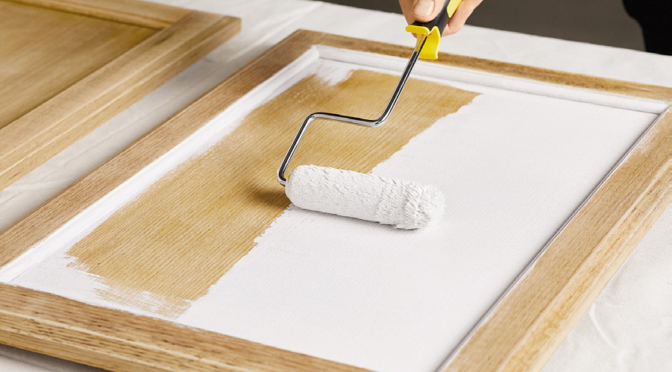Want answers to your most pressing painting problems? PPC’s Ask Your ProPartner™ columnist Dennis Fiorilli is here to help. This time: answers to the most common questions about repainting cabinets.
What paint and primer should be used on laminate cabinets or previously painted cabinets?
Prep is the key! With any paint project I recommend clean, dry, dull and sound. And with any surface prep I must include the warning* shown at the end of this article.
After removing the hardware, I would recommend that the cabinets be thoroughly cleaned with a good cleaner degreaser to remove all grease and oils that normally buildup on kitchen cabinetry over time.
Once cleaned, I would apply a test sample of Extreme Bond Primer in an inconspicuous area. Allow to dry properly and test for adhesion. Because of the exceptional adhesion of this product, sanding may not be necessary for most clean, paintable surfaces.
Once you have established good bonding/adhesion, you can prime the entire surface. Keep in mind: if adhesion is poor, or if any surface prep is short of clean, dry and dull, this may compromise the service length of the system used. A quality wood filler/putty should be used to patch holes or imperfections in the surface.
Many people request the use of a latex finish, and for that reason I would look at Emerald® Urethane Trim Enamel, in a gloss, semi-gloss or satin sheen. This product has excellent flow and leveling characteristics for a smooth and durable finish on cabinets, doors and trim. It also meets the most stringent VOC regulations with <50g/L VOC. It is available in a wide range of colors.
What should be used on worn down, previously stained and sealed wood cabinets?
Again, I recommend clean, dry, dull and sound. And like before I need to mention the warning* about surface prep at the end of this article.
After removing the hardware, I would recommend that the cabinets be stripped back down to bare wood. (If the stained and finished cabinets are in excellent condition, follow the procedures that I mention in the first question).
Once stripped, I would apply a test sample of Premium Wall and Wood Primer in an inconspicuous area. Allow to dry properly and test for adhesion. This step is key, because we want to make sure the sealer is no longer filling the pores of the wood and the primer is able to penetrate and adhere well to the wood.
Once you have established good adhesion, you can prime the entire surface. Again, keep in mind: if adhesion is poor, or if any surface prep is short of clean, dry and dull, this may compromise the service length of the system used. A quality wood filler/putty should be used to patch holes or imperfections in the surface.
For the same reasons I mentioned for laminate cabinets or previously painted cabinets, I recommend Emerald® Urethane Trim Enamel as the topcoat.
What is the best way to prepare varnished kitchen cabinets to be painted over with latex finish paint? Is sanding and undercoating with shellac sufficient?
After removing the hardware, I would recommend thoroughly cleaning the cabinets to remove all greases and oils that normally build up on kitchen cabinetry over time. Once cleaned, I would apply a test sample of Extreme Bond Primer in an inconspicuous area.
After preparing the surface, apply a test area of Extreme Bond, allow to dry properly and test for adhesion. Because of the exceptional adhesion of this product, sanding may not be necessary for most clean, paintable surfaces.
Once you have established good bonding, you can prime the entire surface. Keep in mind that any surface prep short of the total removal of the existing coating may compromise the service length of the system used.
A quality wood filler/putty should be used to patch holes or imperfections in the surface. Shellac-based primers are not normally necessary unless you are working on a fire restoration project.
Since you wanted a latex finish, I would recommend ProClassic® Interior Waterbased Acrylic-Alkyd Enamel Semi-Gloss coating or Gallery Series™ Waterborne Topcoat.
The ProClassic product has excellent flow and leveling characteristics for a smooth and durable finish on cabinets, doors and trim.
Gallery Series Waterborne Topcoat is one of our latest advances and is designed to make it easy for you to offer flawless-looking cabinetry with a hard-wearing, professional-grade finish that meets Kitchen Cabinet Manufacturers Association® (KCMA) requirements when properly applied.
Best of all, this professional-grade coating dries to the touch just 30 minutes after application, and can be recoated in as little as 45 minutes. Formulated for spray application, it offers excellent flow and leveling. And as a self-sealing, single-component formula, Gallery Series combines the convenience of no on-site mixing with the performance of a two-part enamel coating.
As with any paint project I recommend clean, dry, dull and sound. And with any surface prep I must include the following warning.
Important! Read this before you prep
*WARNING! Removal of old paint by sanding, scraping or other means may generate dust or fumes that contain lead. Exposure to lead dust or fumes may cause brain damage or other adverse health effects, especially in children or pregnant women. Controlling exposure to lead or other hazardous substances requires the use of proper protective equipment, such as a properly fitted respirator (NIOSH approved) and proper containment and cleanup.
For more information, call the National Lead Information Center at 1-800-424-LEAD (in the US) or contact your local health authority. Removal must be done in accordance with EPA Renovation, Repair and Painting rule or similar state regulation.
This article was originally published in the Fall 2023 issue of PPC. ©2023 Randall Reilly. Dennis Fiorilli is Director of Product Excellence at Sherwin-Williams and took over the reins of the long-running PPC Ask Your ProPartner™ column in 2023. For more answers to professional painter’s product and application questions, visit the PPC magazine archive.

